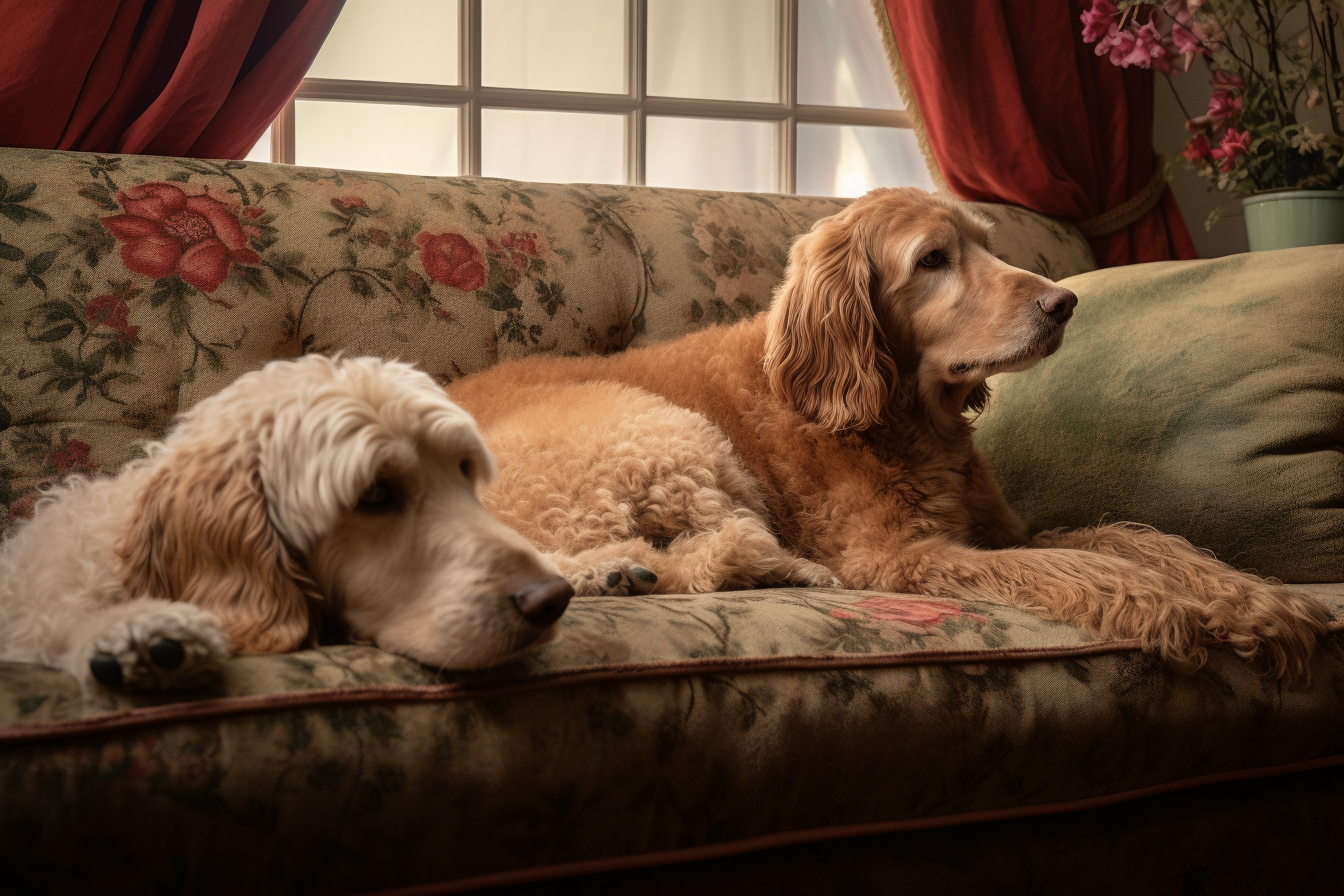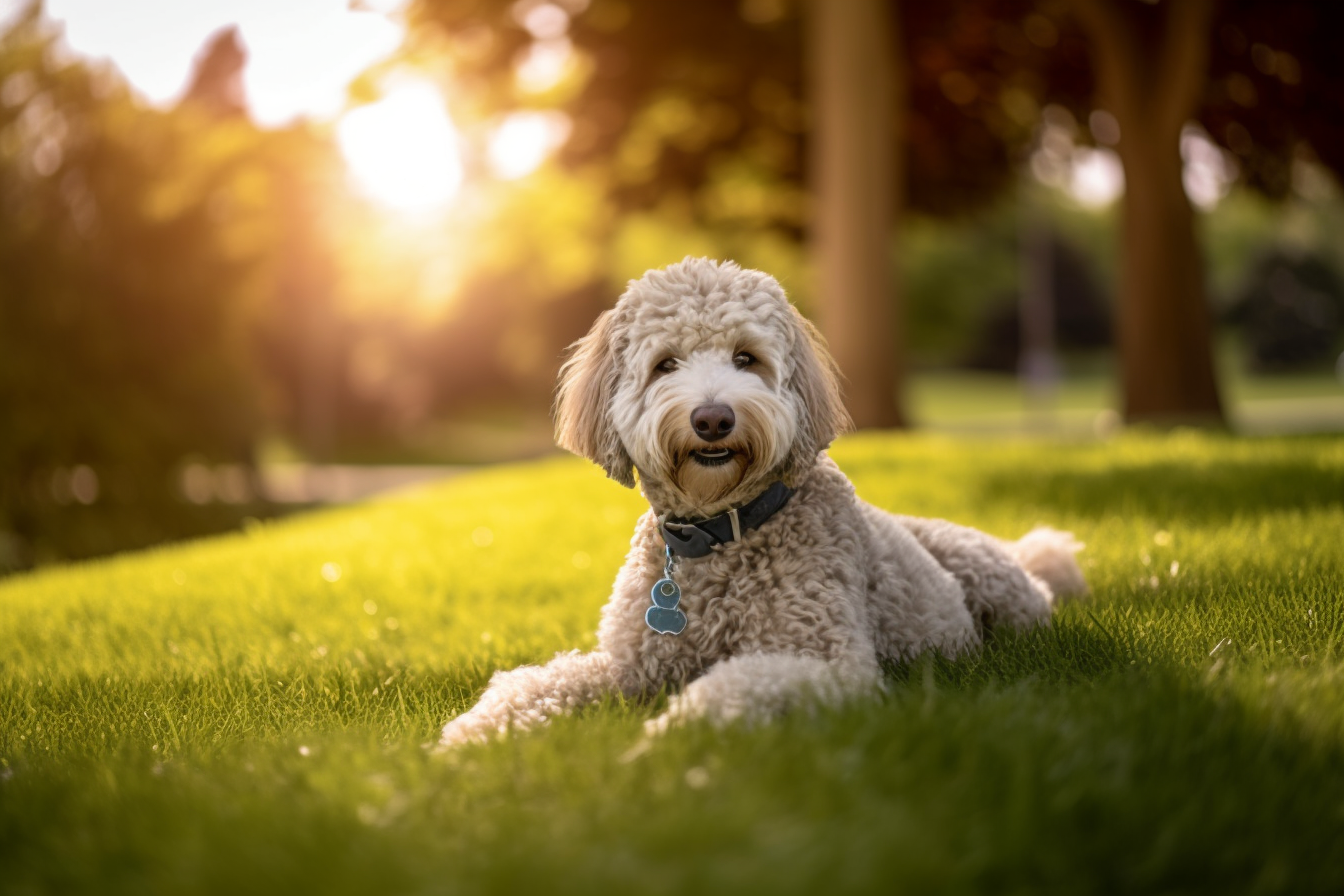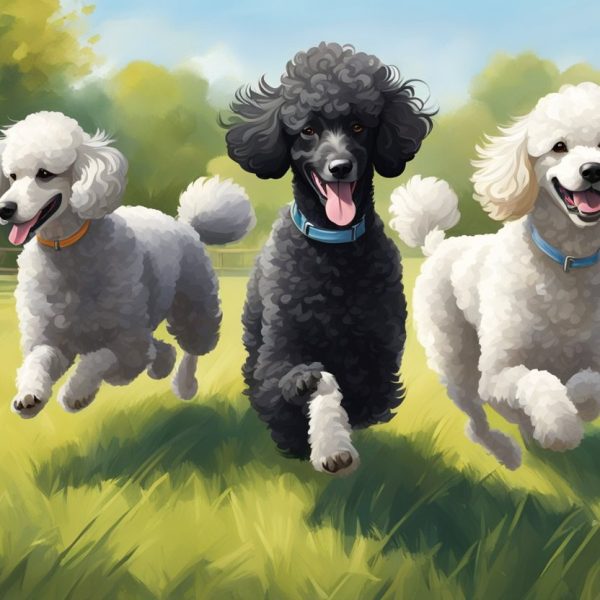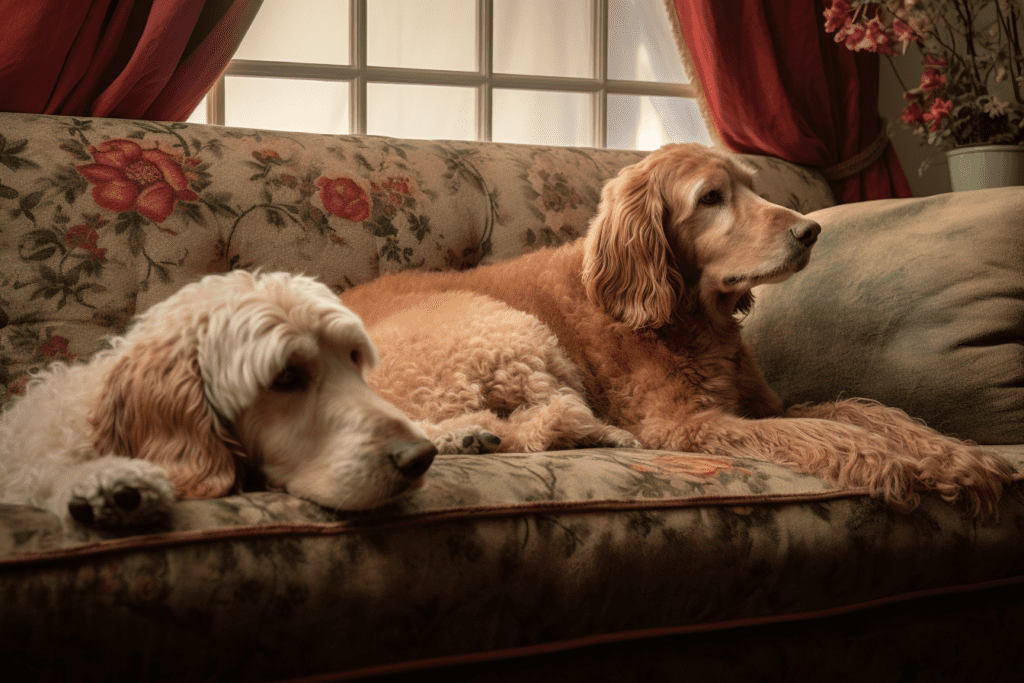
Introduction
Hey there, fellow doodle dog lover! You’re in the right place if you’re as captivated by Labradoodles and Goldendoodles as we are. These fluffy, friendly, and intelligent breeds have stolen the hearts of many. Still, it’s essential to know the differences between them. After all, every doodle dog is unique!
In this article, we’ll dive into the world of Labradoodles and Goldendoodles to uncover what sets them apart. We’ll explore their origins, appearance, temperament, and more. By the end, you’ll have a better understanding of these two charming breeds and be better equipped to choose the perfect doodle companion for your lifestyle. So, let’s start on our journey to unravel the puzzle of Labradoodles vs. Goldendoodles puzzle!
Origin and Breeding
- Labradoodle
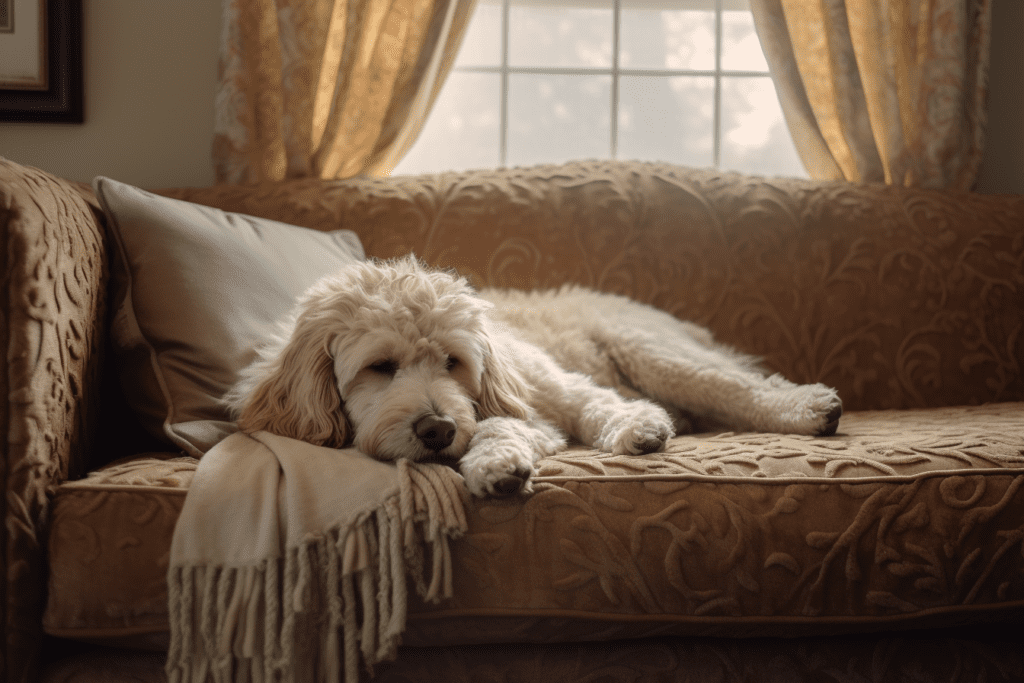

Let’s begin with the lovable Labradoodle! The Labradoodle was first introduced in Australia in the 1980s when a breeder named Wally Conron crossed a Labrador Retriever with a Poodle. His goal? To create a hypoallergenic guide dog that could assist people with allergies. And voilà!
The Labradoodle was born, stealing hearts left and right.
As you know, Labradoodles are a cross between a Labrador Retriever and a Poodle. This mix brings together the best of both worlds: the friendly, easy-going nature of the Lab and the intelligence and low-shedding coat of the Poodle.
- Goldendoodle


Next up, the gorgeous Goldendoodle! The Goldendoodle emerged in the early 1990s, following the Labradoodle’s lead. Breeders in the United States and Australia wanted to create another hypoallergenic option for families and service dog organizations. So, they combined a Golden Retriever with a Poodle, and the Goldendoodle came to be.
The Goldendoodle, like the Labradoodle, is a mix of two fantastic breeds. With the loyal and affectionate temperament of the Golden Retriever and the smarts and low-shedding coat of the Poodle, Goldendoodles make the perfect addition to many families.
Now that we’ve covered the origins of our furry friends, let’s move on to their appearances and sizes, which can be pretty diverse! So get ready to explore the world of doodle coats, colors, and sizes!
Appearance and Size
- Labradoodle
Labradoodles come in a delightful array of coat types, colors, and sizes. So, there’s a good chance you’ll find one that’s just right for you!
When it comes to coat types, Labradoodles can have a fleece, wool, or hair coat. Fleece coats are silky, wavy, or curly and are often low-shedding. Wool coats are denser, with tight curls similar to a Poodle’s coat. Hair coats, on the other hand, are more like a Labrador Retriever’s coat and can shed more than the other two types.
Color-wise, Labradoodles are quite diverse! They can be chocolate, black, cream, apricot, red, or even particolored (a mix of two or more colors). It’s like a rainbow of doodles!
As for size, Labradoodles typically come in three variations: standard, medium, and miniature. The standard Labradoodle can weigh between 50 and 65 pounds, while medium Labradoodles range from 30 to 45 pounds. Finally, miniature Labradoodles, the smallest of the bunch, weigh between 15 and 25 pounds.
- Goldendoodle
Goldendoodles are just as varied in their appearance and size! So let’s take a closer look.
Goldendoodles can have straight, wavy, or curly coats. Straight coats are similar to a Golden Retriever’s coat, while wavy coats have a slight curl and are low-shedding. Curly coats, resembling a Poodle’s coat, are the most hypoallergenic of the three types.
When it comes to colors, Goldendoodles can be cream, apricot, red, chocolate, or black. They’re a colorful bunch, just like their Labradoodle cousins!
Goldendoodles also come in three size variations: standard, medium, and miniature. Standard Goldendoodles can weigh between 50 and 75 pounds, medium Goldendoodles range from 30 to 50 pounds, and miniature Goldendoodles weigh between 15 and 30 pounds.
Now that we’ve explored the appearances and sizes of these adorable doodles, it’s time to delve into their temperaments and behaviors. So get ready to learn more about what makes these breeds truly special!
Temperament and Behavior
- Labradoodle
When it comes to temperament, Labradoodles are known for their friendly, affectionate, and social nature. They’re always eager to make new friends with humans or other animals. With their Labrador Retriever and Poodle genes, it’s no wonder they’re such lovable companions!
Labradoodles are energetic, but their activity levels can vary depending on their specific genetic makeup. For example, some Labradoodles might be more laid-back like Labradors, while others could inherit the Poodle’s zest for life. Regardless, Labradoodles typically need regular exercise to keep them happy and healthy.
As for their social behavior, Labradoodles tend to be great with children and other pets. Their easy-going personalities make them adaptable to various living situations. They’re known to thrive in city apartments and spacious homes in the countryside.
- Goldendoodle
Goldendoodles are similarly known for their warm, friendly, and affectionate temperaments. These gentle giants have big hearts and love being around people, making them excellent family pets.
Like Labradoodles, Goldendoodles have varying energy levels based on their specific genetic background. However, they generally need a good amount of exercise to stay fit and content. So a daily walk or romp in the park will keep your Goldendoodle’s tail wagging!
Goldendoodles are also excellent with children and other pets. They’re patient, gentle, and eager to please, making them great playmates for little ones and furry friends alike. They adapt well to different environments and can be just as happy in an urban setting as they are in a more rural area.
Now that we’ve covered the temperaments and behaviors of these two delightful breeds let’s move on to their health and lifespan. Keep reading to learn more about how to keep your doodle dog happy and healthy for years to come!
Health and Lifespan
- Labradoodle
Like all breeds, Labradoodles can be prone to certain health issues. However, being a mixed breed, they may benefit from what’s called “hybrid vigor,” which means they’re generally healthier than their purebred counterparts. Nevertheless, it’s essential to be aware of the potential health concerns.
Common health issues in Labradoodles include hip and elbow dysplasia, eye diseases such as progressive retinal atrophy (PRA), and certain skin allergies. Regular check-ups with your veterinarian and keeping an eye out for any unusual symptoms can help ensure your Labradoodle stays in tip-top shape.
As for life expectancy, Labradoodles have a fairly long lifespan for a dog. They typically live between 12 to 15 years, with proper care and attention to their health needs.
- Goldendoodle
Goldendoodles also enjoy the benefits of hybrid vigor but can still be susceptible to specific health issues. Awareness and regular vet visits are vital to keeping your Goldendoodle healthy and happy.
Some common health concerns in Goldendoodles include hip and elbow dysplasia, ear infections, and certain eye diseases like PRA. Ensuring your Goldendoodle gets regular exercise, a balanced diet, and proper grooming can help prevent some of these issues.
When it comes to life expectancy, Goldendoodles have a similar lifespan to Labradoodles. They generally live between 12 to 15 years, depending on their size, genetics, and overall health.
Now that we’ve covered these doodle breeds’ health and lifespan let’s discuss grooming and maintenance. Please keep reading to learn how to keep your doodle dog looking and feeling their best!
Grooming and Maintenance
- Labradoodle
When it comes to grooming, Labradoodles require a bit of TLC to keep their coats healthy and tangle-free. Depending on their coat type, your Labradoodle may need more or less grooming attention.
Fleece and wool-coated Labradoodles usually require regular brushing to prevent matting. Aim for at least two to three times a week, but daily brushing is even better! Hair-coated Labradoodles might need less frequent brushing, but they’ll still occasionally benefit from a good comb-through.
Labradoodles also need regular baths and professional grooming every six to eight weeks to keep their coats in top condition. Remember to clean their ears and trim their nails, too!
As for exercise, Labradoodles need regular physical activity to stay happy and healthy. A daily walk, fetch in the park, or even a swim can help keep your Labradoodle’s energy levels in check.
- Goldendoodle
Goldendoodles also require regular grooming to keep their coats looking and feeling great. The grooming routine for your Goldendoodle will depend on their coat type.
Straight and wavy-coated Goldendoodles generally need brushing two to three times a week to prevent tangles and matting. Curly-coated Goldendoodles, with their denser curls, might need daily brushing to avoid mats and keep their coats in good shape.
Bathing and professional grooming every six to eight weeks are also essential for Goldendoodles. And just like Labradoodles, clean their ears and trim their nails regularly.
Goldendoodles enjoy daily exercise, whether walking around the neighborhood, playing fetch, or even swimming. Regular physical activity is vital for their health and well-being.
Now that we’ve covered grooming and maintenance let’s explore how to choose the right doodle breed for your lifestyle. Read on to discover the perfect doodle companion for you!
Choosing the Right Breed for Your Lifestyle
Finding the perfect doodle companion for your lifestyle is an exciting adventure! Both Labradoodles and Goldendoodles make fantastic family pets. Still, it’s essential to consider your specific living situation and lifestyle needs to find the best match.
Start by thinking about the size and space you have available. Larger doodle breeds might be happier in a spacious home with a yard. In contrast, smaller doodles can adapt well to apartment living. But remember, even the smallest doodle still needs regular exercise and outdoor time!
Consider your family dynamics, too. Both Labradoodles and Goldendoodles are generally excellent with children and other pets, but individual temperaments can vary. So, again, meeting a potential doodle friend and observing their behavior can help you make the right choice.
Remember grooming and maintenance! Are you prepared to invest time and effort into regular brushing, bathing, and professional grooming? Be honest about your ability and willingness to commit to your doodle’s grooming needs.
Finally, consider your activity level and how it aligns with your doodle’s energy. Labradoodles and Goldendoodles love to exercise and playtime, so ensure you’re ready to keep up with their enthusiasm!
Considering these factors, you’ll be well on your way to finding the perfect doodle companion to share your life with. Happy doodle hunting!
Adopting or Purchasing a Labradoodle or Goldendoodle
When it comes to bringing a Labradoodle or Goldendoodle into your home, you have a few options to consider. Adopting and purchasing have pros and cons, and weighing them carefully is essential to make the best decision for your family and lifestyle.
- Adoption
Adopting a Labradoodle or Goldendoodle from a rescue organization or shelter is a wonderful way to give a dog a second chance at a loving home. However, adopting an adult doodle can also offer some advantages, such as a potentially lower adoption fee compared to purchasing a puppy, and the dog’s personality and size may already be established.
When adopting, be prepared for the possibility of some unknowns about the dog’s history and health. Take the time to work with the rescue organization to understand the dog’s needs and ensure they’re a good match for your family.
- Purchasing
Purchasing a Labradoodle or Goldendoodle puppy from a reputable breeder allows you to learn more about the dog’s genetic background, health, and temperament. In addition, a responsible breeder will provide health guarantees and may even offer support as you raise and train your doodle puppy.
When purchasing a puppy, be prepared for the financial investment and the time commitment required for proper socialization and training. Always research the breeder thoroughly and avoid puppy mills or backyard breeders.
Whether you choose adoption or purchasing, bringing a Labradoodle or Goldendoodle into your life will be a rewarding and heartwarming experience. Remember to take your time and make a well-informed decision to ensure a happy life together.
Q1. Are Labradoodles and Goldendoodles hypoallergenic?
Although no dog breed is 100% hypoallergenic, Labradoodles and Goldendoodles are often considered more suitable for allergy sufferers. This is because their low-shedding coats, inherited from their Poodle parent, produce fewer allergens. However, individual dogs can still trigger allergies, so it’s a good idea to spend time with a doodle before bringing one home if you have allergy concerns.
Q2. Which breed is easier to train: Labradoodle or Goldendoodle?
Labradoodles and Goldendoodles are intelligent breeds that are relatively easy to train. Their eagerness to please and quick learning abilities are traits they inherit from their Labrador Retriever, Golden Retriever, and Poodle parents. However, each dog is unique, so individual trainability may vary.
Q3. Are Labradoodles or Goldendoodles better with children?
Labradoodles and Goldendoodles are known for their friendly, affectionate, and gentle temperaments, making them excellent family pets. They’re generally great with children, but it’s important to remember that every dog is an individual. So when choosing a doodle for your family, observe their behavior around children to ensure they’re a good fit.
Q4. What is the price range for Labradoodles and Goldendoodles?
The cost of a Labradoodle or Goldendoodle puppy can vary widely depending on factors like the breeder’s location, the puppy’s coat and color, and the parents’ pedigrees. However, on average, you can expect to pay between $1,000 to $3,000 for a doodle puppy. Remember, it’s essential to find a reputable breeder who prioritizes the health and well-being of their dogs.
Q5. Can Labradoodles and Goldendoodles thrive in apartment settings?
While Labradoodles and Goldendoodles are adaptable breeds that can adjust to different living situations, it’s important to consider their size and exercise needs. Smaller doodles, like miniature Labradoodles and Goldendoodles, might be better suited for apartment living. However, all doodles need regular exercise and outdoor time, regardless of their living space.
Q6. Should I adopt or purchase a Labradoodle or Goldendoodle?
Whether to adopt or purchase a Labradoodle or Goldendoodle depends on your preferences and circumstances. Both options have their advantages and drawbacks.
Adopting a doodle from a rescue organization or shelter is a wonderful way to give a dog a second chance at a loving home. Adopting an adult doodle may come with benefits such as lower adoption fees and a more established personality and size. However, there may be some uncertainties regarding the dog’s history and health.
Purchasing a doodle puppy from a reputable breeder allows you to learn more about the dog’s genetic background, health, and temperament. In addition, a responsible breeder will provide health guarantees and may offer support as you raise and train your doodle puppy. However, purchasing a puppy requires a significant financial investment and a commitment to proper socialization and training.
Ultimately, whether you adopt or purchase a Labradoodle or Goldendoodle, you’ll bring a loving and loyal companion into your home. So make sure to carefully consider your options and choose the best path for your family and lifestyle.
Conclusion
Ultimately, whether you adopt or purchase a Labradoodle or Goldendoodle, you will find a loving, loyal, and fun companion to share your life with. These doodle breeds bring joy, laughter, and endless cuddles to countless families, making them a popular choice for dog lovers everywhere. So as you embark on your journey to find your perfect doodle, remember to cherish the moments, embrace the love they bring, and enjoy the adventure. Take your time to consider your options and make a well-informed decision to ensure a happy life together. Ready to learn more about these amazing breeds? Continue exploring our site for even more in-depth information, heartwarming stories, and helpful tips to make your doodle experience the best it can be!

